Welcome to Start TODAY. Sign up for our Start TODAY newsletter to join the 30-day challenge and receive daily inspiration sent to your inbox.
Coming off a month of focusing on upper body only, we're now transitioning to a full-body strength routine by adding in the lower body, too.
Ready to keep walking? Good! We are keeping up with our daily walks, but on the strength training days, the walk is optional. You can also add the strength workouts to any cardio routine you already have in place, so if you’d rather bike, swim, run or take a HIIT class — go for it!
New to Start TODAY? Start by making walking a habit with this 30-day plan.
A 31-day walking and strength-training plan for beginners
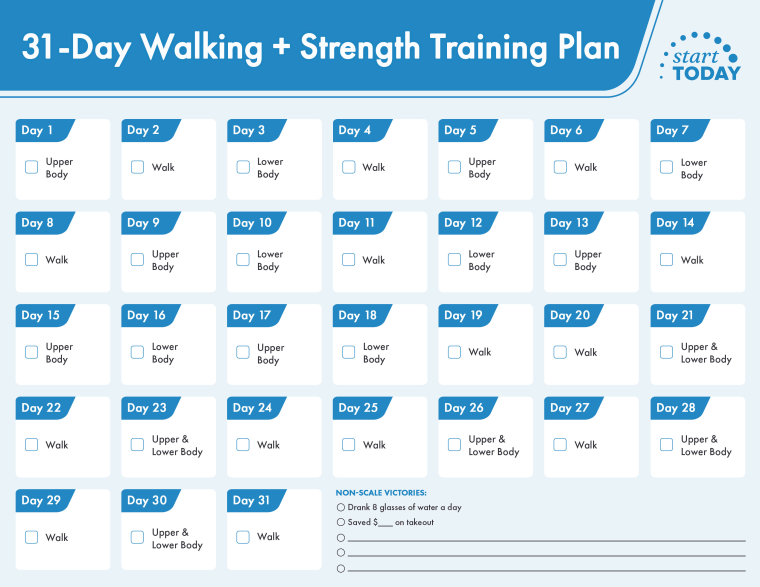
Download a printable calendar here.
Day 1: Upper
Day 2: 20-minute walk
Day 3: Lower
Day 4: 30-minute walk
Day 5: Upper
Day 6: 20-minute walk
Day 7: Lower
Day 8: 30-minute walk
Day 9: Upper
Day 10: Lower
Day 11: 30-minute walk
Day 12: Lower
Day 13: Upper
Day 14: 30-minute walk
Day 15: Upper
Day 16: Lower
Day 17: Upper
Day 18: Lower
Day 19: 20-minute walk
Day 20: 20-minute walk
Day 21: Upper & Lower
Day 22: 30-minute walk
Day 23: Upper & Lower
Day 24: 45-minute walk
Day 25: 20-minute walk
Day 26: Upper & Lower
Day 27: 30-minute walk
Day 28: Upper & Lower
Day 29: 45-minute walk
Day 30: Upper & Lower
Day 31: 45-minute walk
NSV's: Tracking non-scale victories
Last month Start TODAY member Melissa Paluch was featured on the TODAY show. Yes, she has lost 100 pounds by walking and meal prepping healthy recipes. But it’s the NSV's or non-scale victories that have really transformed her life: from going down in clothing size, to sleeping better, to saving the money she would’ve spent on takeout for a vacation fund.
This month, we are all going to follow her lead. You’ll see there’s room on the calendar to track your non-scale victories. These are benefits that come as a result of committing to a fitness routine that have nothing to do with your weight. In my experience as a trainer, I've seen that tracking progress in this way tends to keep people motivated and committed to a routine more so than relying on the scale. And members of our Start TODAY community are proof that losing weight is just the tip of the iceberg.
Some examples of non-scale victories include:
- Drank 8 glasses of water a day.
- Saved money by cooking at home instead of ordering takeout.
- Increased energy or better mood.
- Clothes fitting better.
- Walking instead of watching TV or scrolling on your phone.
- Added veggies to dinner every night.
- Can walk further or faster than when you started.
The benefits of strength training
Many people assume the main reason to incorporate strength training into their routine is to tone the body. While strength training increases muscle mass that can lead to tighter, toned muscles, it’s far from the only benefit.
Strength-training exercises improve bone density and increase flexibility in the joints. Building strength in your muscles also helps improve balance, speed up the metabolism and burn calories. Muscle mass decreases naturally with age, so as you get older incorporating strength-training workouts into your regimen becomes even more important. Strength training has also been largely associated with preventing injury.
The health benefits of walking — and why you should mix it up
In addition to strength training, we’ll also continue with our walks to help with cardiovascular shape and mobility. This month, I’ve upped the ante from our typical 20-minute walks and varied the walking times.
Varying the lengths of your walks not only keeps them more interesting and challenging, but also encourages your cardiovascular and muscular system to work in different ways.
Changing it up and keeping your body guessing can help with weight loss (if that's one of your goals) and improves muscle endurance, stamina and cardiovascular health. Your usual 20 minutes may feel easier, and a longer walk may become your new norm, which will burn more calories, speed up your metabolism and improve your circulation.
If walking for 30 or 45 minutes is too much physically, or your schedule doesn't allow for it, you can break it up throughout the day. Three, ten- or 15-minute bursts is equally as effective as one longer walk. The point is to increase your time or distance - whether you break it up or do it all in one shot — to increase your step count, combat a sedentary lifestyle and speed up your metabolism.
Strength-training routine for beginners
The strength-training plan features five upper-body exercises with dumbbells and five lower-body exercises done using your bodyweight. Perform 10 repetitions of each exercise and then repeat for a total of three rounds. For example, on upper-body days, you’ll do every exercise 10 times, and then once you’ve finished one round, you’ll complete two more rounds.
If you don’t have dumbbells for the upper-body exercises, you can grab water bottles or soup cans. I recommend starting with 3-pound dumbbells, unless you’ve used weights before and feel comfortable with 5- or 7-pound weights. For upper body and core, start with 10 repetitions. Then, to make things more challenging after a couple of weeks, increase to 15 repetitions.
For lower body, I’ve provided modifications for every exercise. If any of the moves bother your knees, stick with the modifications!
Upper body strength routine

Bicep curl
Grab your dumbbells and start with your arms hanging by your sides. Hug your elbows in toward the side of your body, and then curl the weights up toward your shoulders. Slowly lower them back down. Keep pressing the elbows in toward your side, and be careful not to let your arms swing. If your arms are swinging, your weights may be too heavy.
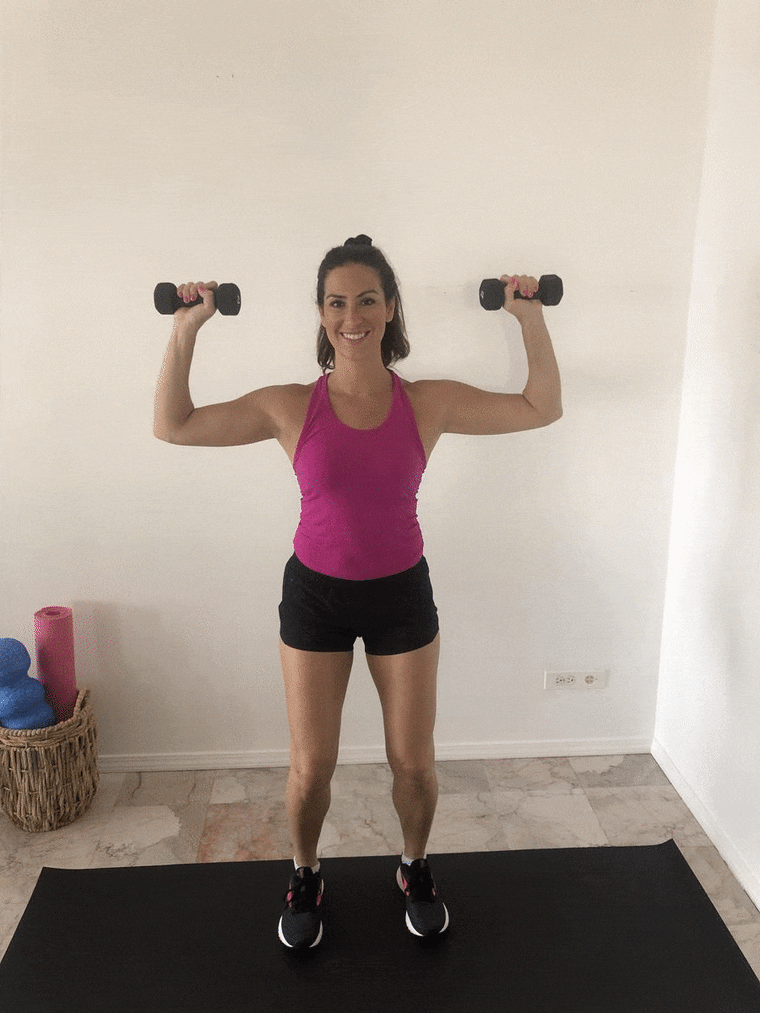
Overhead press
Stand with your feet as wide as the shoulders and hold one dumbbell in each hand. Bring the dumbbells up to a goal post position at shoulder height. Press the weights up toward the ceiling, so that they are slightly in front of your head (just enough so you can see the weights with your eyes without looking up with your neck). Relax the neck and keep your shoulders down away from the ears. Bring the weights back to the goal post position.
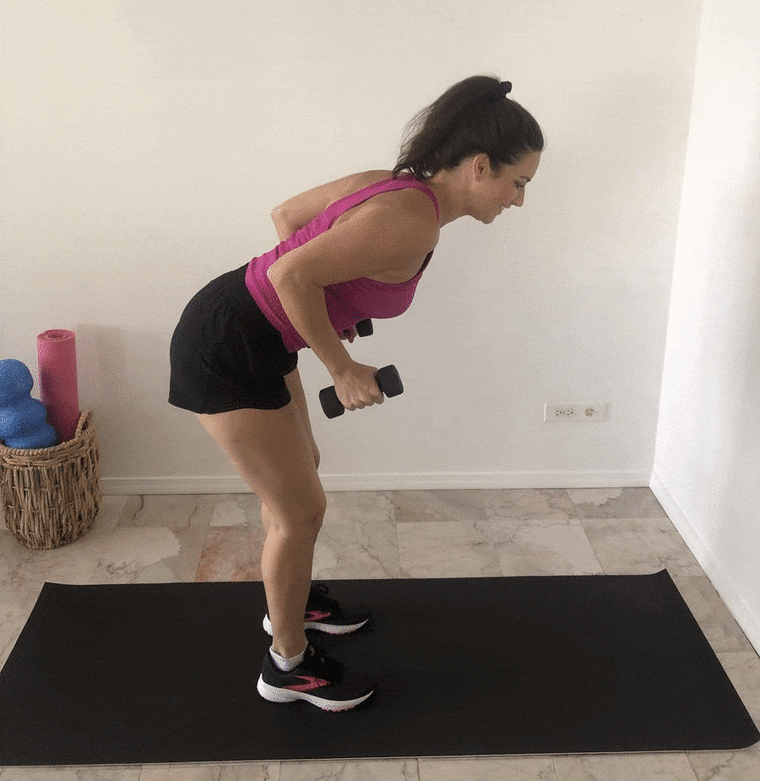
Tricep kickbacks
Holding a weight in each hand, hinge forward at the hips with a flat back. Hug your elbows in toward your sides, and kick the weight toward the back of the room by moving the arm below the elbow only. Feel the back of your arm tighten as you press the arm back, and then release it back to the starting position.
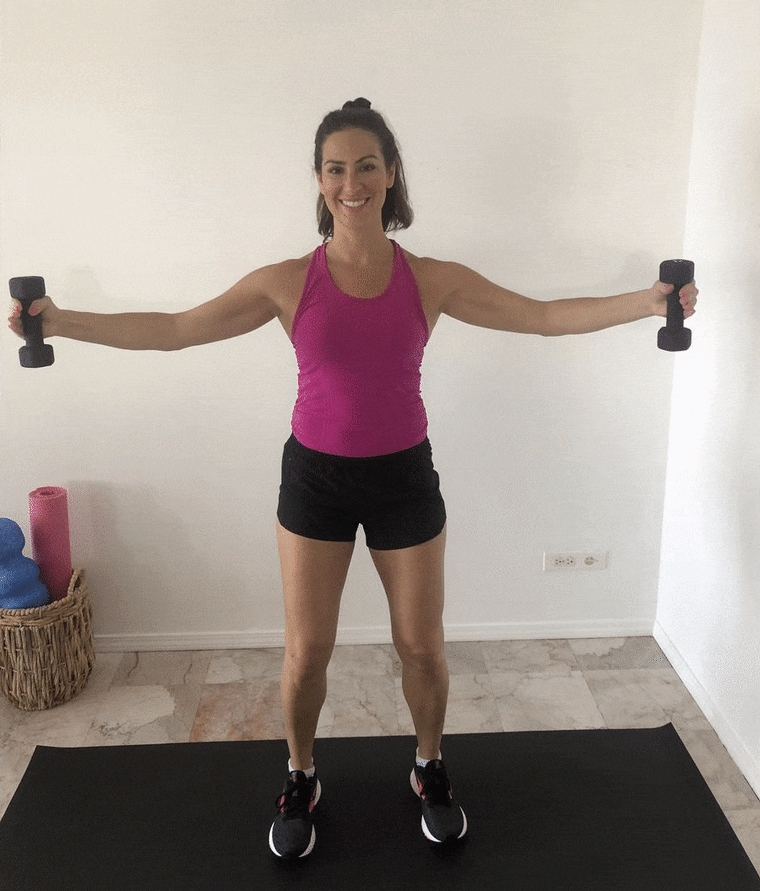
Hug a tree
Hold the weights out to your sides at shoulder height, parallel to the floor. Relax the shoulders down, and then pull the arms toward the front of you as if you’re hugging a tree. Keep the elbows level with your arms — don’t let them dip down — and be conscious of the shoulders starting to raise up. If this happens, it means the weight is too heavy or you’re too fatigued, so you can either perform less reps or decrease the weights.
Serve a platter
Start with your arms at your sides. Bend your elbows at a 90-degree angle so that the weights are out in front of you. Reach the arms straight forward, as if you’re serving a platter, and then pull them back in toward you. Keep the palms facing up the entire time.
Lower-body strength routine
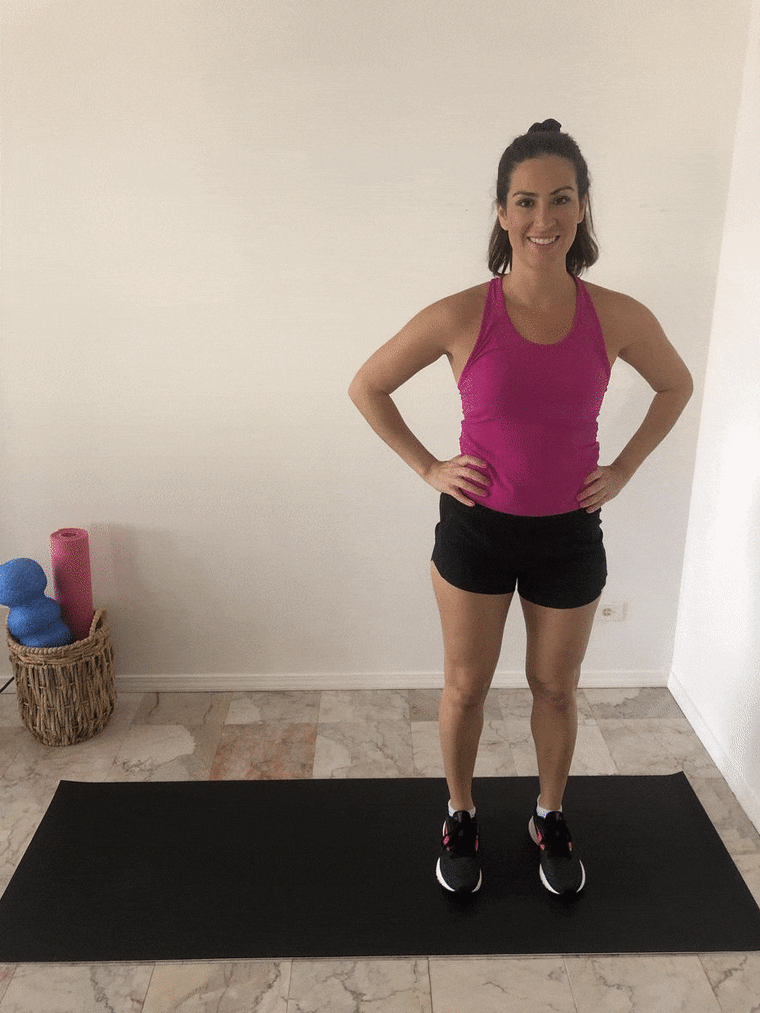
Side lunge
Stand with your feet hip-width apart, and then step your right foot a few feet to the right as you bend the right knee. Keep the left leg straight, and sink back into your right glute. Press down through the right heel to come up to the starting position. Repeat 10 times and then switch sides.
Modification: Standing side leg raises
Stand with your feet hip-width apart and step the right foot to the right so that your toe is resting on the ground and your weight is in the left foot. Point the foot and engage the quad. Lift the leg up as high as the hip, and lower it down. Repeat 10 times, and then switch to the left leg.
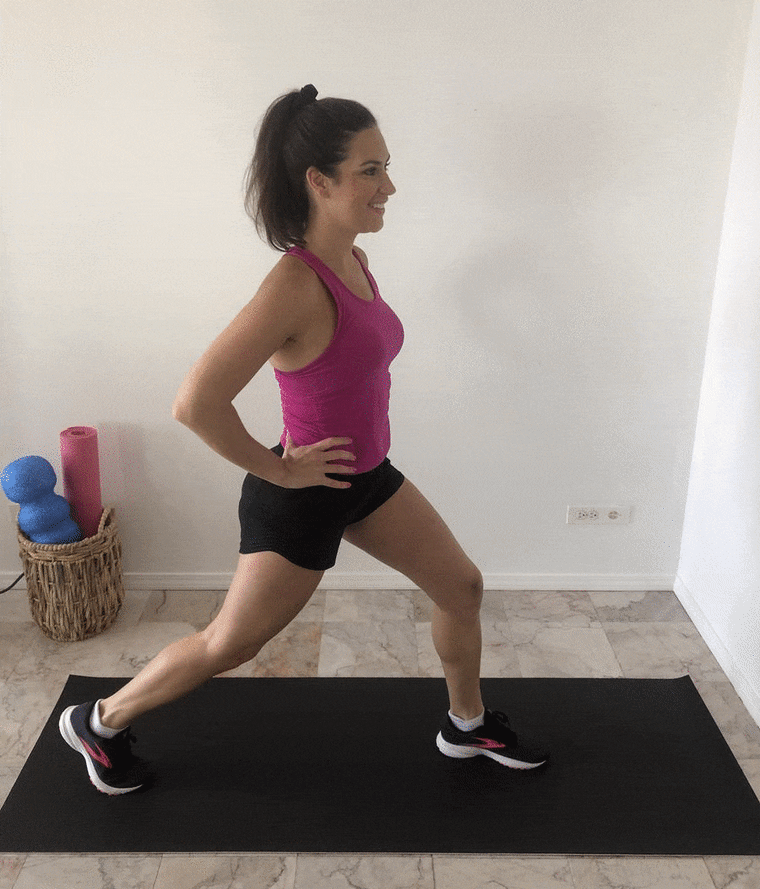
Stationary lunge
Stand with your feet as wide as your hips and your hands on your hips. Step your left foot back a few feet. This is your starting position. Bend the right knee so that it is over the right ankle, and bend your left knee so that the knee reaches down toward the ground. Look in the mirror and make sure your spine stays straight up and down and that you’re not leaning forward. Press down through the front heel to come up to the starting position. Repeat this 10 times then switch sides.
Modification: Standing leg lifts
Stand with your feet hip-width apart. Point your right foot in front of you and squeeze the quad. Lift the leg up almost as high as your hip, and then lower it down. Repeat 10 times and then switch to the left leg.
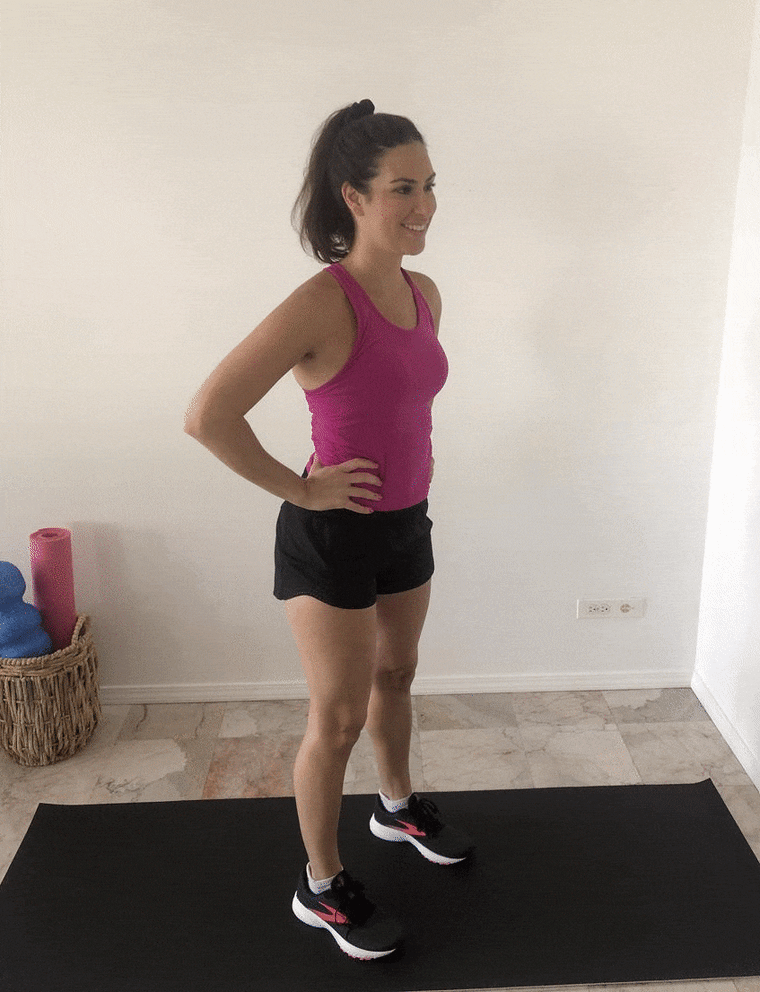
Squat
Begin standing with your feet as wide as the shoulders, toes pointing forward. Bend at the hips and knees while keeping your heels and toes on the floor. Slowly sit back into a squat position with your chest up, your shoulders back and abs in. Make sure that your knees are not crossing over your toes, and that you are as close to a 90-degree angle as possible. Straighten your legs by pressing into your heels to stand back up. Squeeze your glutes at the top, tilting your pelvis forward.
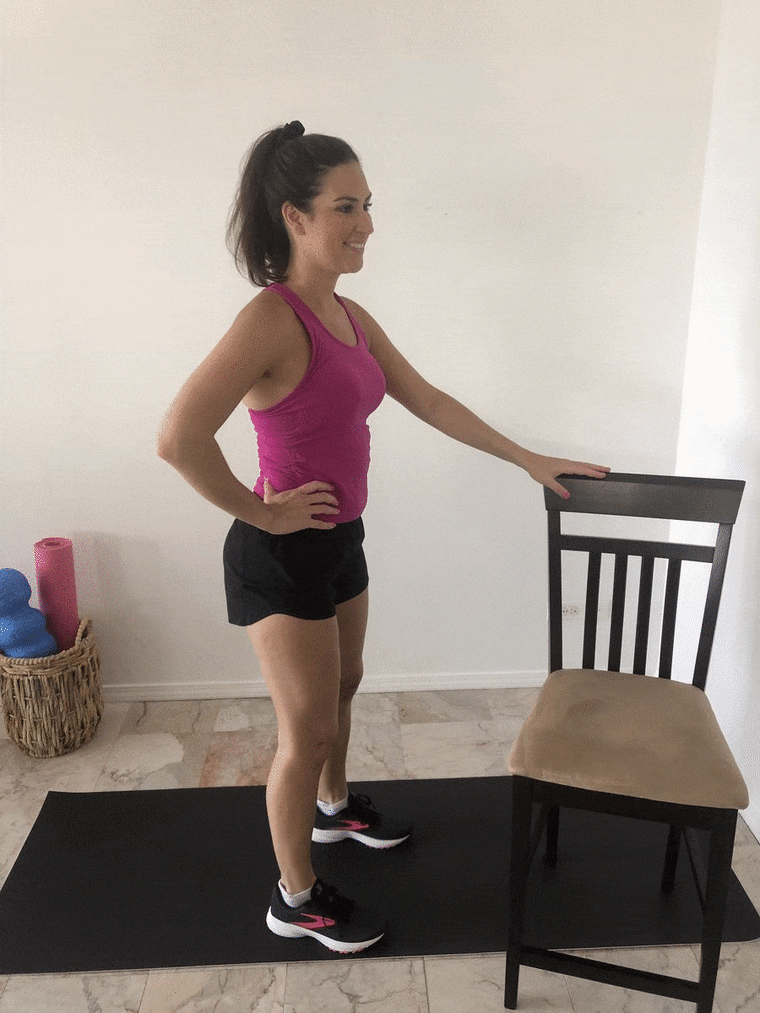
Modification: Modified squat
Holding onto a counter, chair or table with one hand for balance, step the feet out as wide as the shoulders. Sit your glutes back and bend your knees to lower into a half squat. Keep the knees over the toes and pull the abs in. Press down through the heels to stand back up.
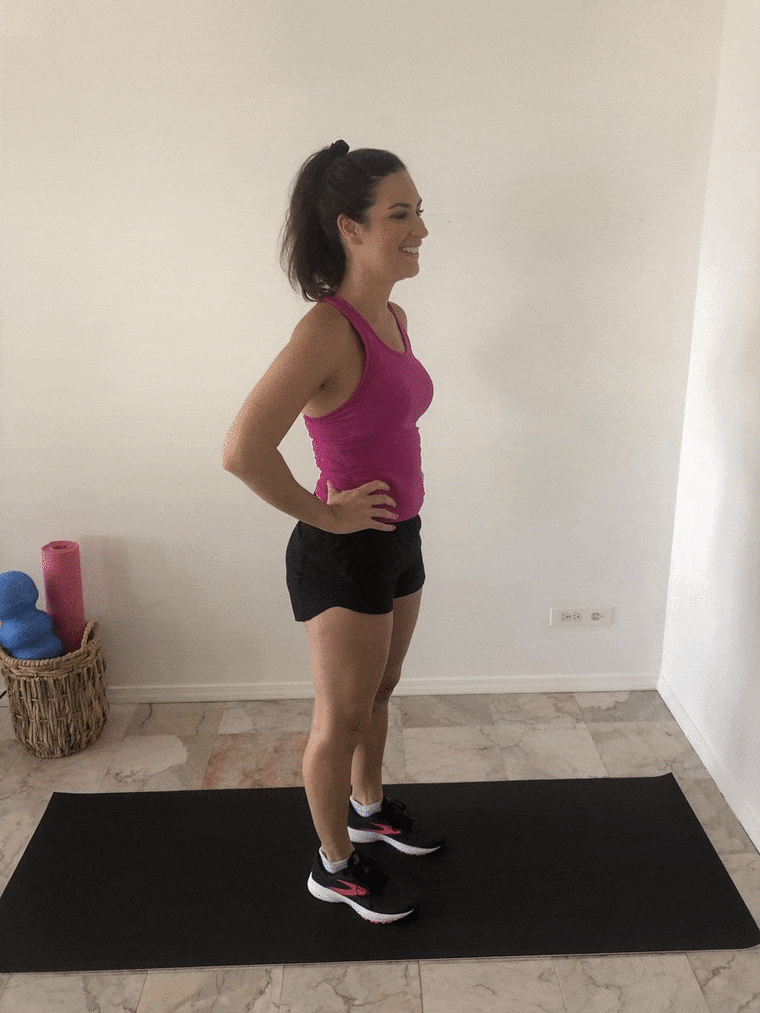
Calf raises (all levels)
Stand with your feet as wide as your hips. Come up onto the toes to lift the heels off of the ground. Then lower the heels down. Repeat 10 times.
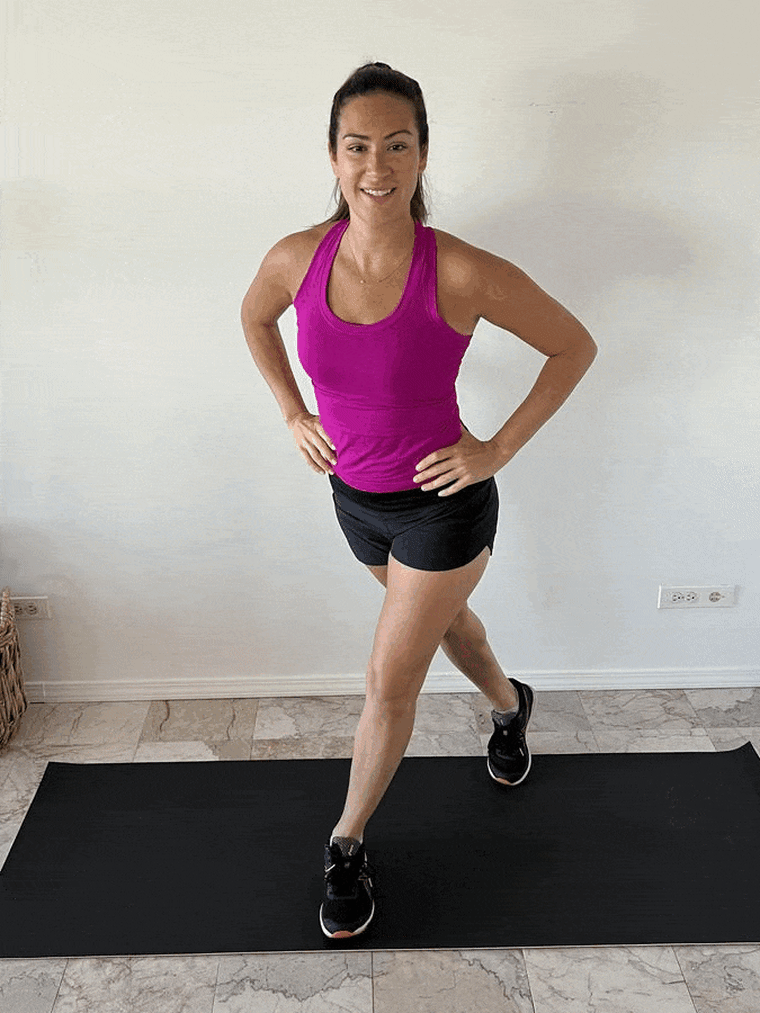
Curtsy lunge
Standing on your feet with your feet as wide as your shoulders, step your right foot back behind your left and to the left of your left foot. Bend both knees as you lower down into a lunge in this curtsy position. Then press down through your left heel to bring your right leg back to center.
Modification: Standing with your feet as wide as your hips, balance on your left foot as you bring the right knee up toward your waist in front of you. Lower the foot down.
